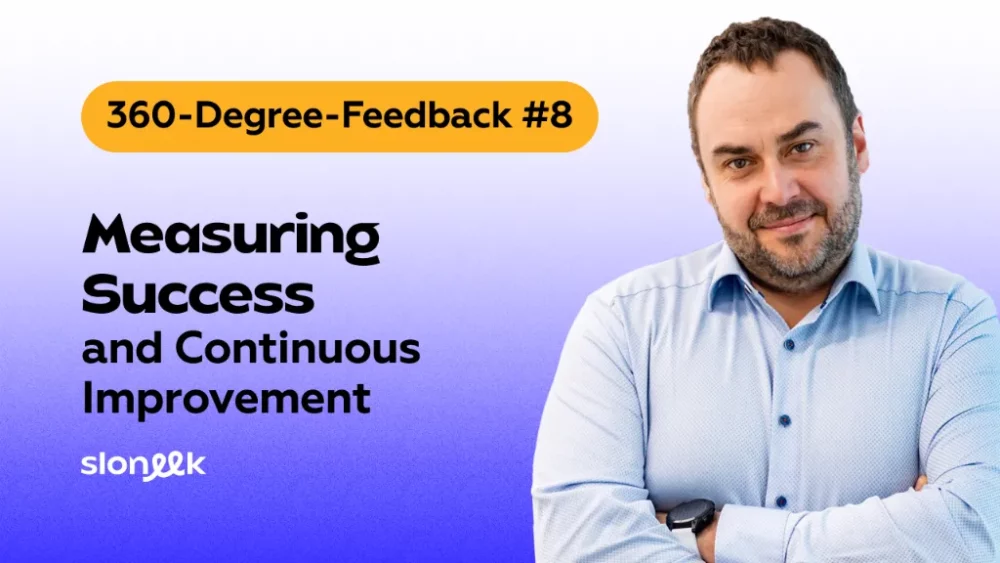360-Degree-Feedback #8: Measuring Success and Continuous Improvement

You might be thinking, “We’ve finally completed the 360-degree feedback, we’ve had the feedback conversations, and people have created their development plans. We’re done.” But your project is just beginning. Now comes the most important question: How do you know it was worth it?
How to Measure the Success of a Development Tool
Measuring the effectiveness of 360-degree feedback is a challenge because you’re evaluating changes in behavior and competencies that manifest gradually. It’s not like sales, where you see results immediately.
Immediate Indicators (First Months)
These metrics tell you how the process went:
Quantitative Indicators:
- Rater participation rate (target: above 85%).
- Timeliness of completion (target: 90% on time).
- Number of completed feedback conversations.
- Number of created development plans.
Qualitative Indicators:
- Participant satisfaction with the process.
- Perceived usefulness of the feedback.
- Quality and specificity of comments.
- Manager engagement in the process.
Mid-Term Indicators (6-12 Months)
Here, you can start to see the real impact:
Progress on Development Plans:
- What percentage of people are actively working on their IDP?
- What development activities have been implemented?
- Satisfaction with support from managers.
Changes in Behavior:
- Manager observations of behavioral changes.
- Team feedback on improvements.
- The reviewed individuals’ own sense of progress.
Dana from a manufacturing company tracks progress very systematically: “Every quarter, I sit down with the managers and ask, ‘Have you noticed any changes in the people who went through the 360-degree feedback?’ I often get specific stories about how someone started delegating better or communicating more effectively. While this is non-quantifiable data, it’s very valuable.”
Long-Term Indicators (12+ Months)
Here, you see the real impact on the organization:
Repeated 360-Degree Feedback:
- Improvement in target competencies.
- Progress in gap analysis.
- New development needs.
Organizational Metrics:
- Employee engagement (especially in teams with developed leaders).
- Talent turnover.
- Internal leadership ratings.
- Team atmosphere.
Learning from Data—What the Results Tell You About the Organization
360-degree feedback provides more than just individual data. Aggregated results are a valuable source of information about the entire organization.
Mapping Strengths and Gaps
When you analyze data from all assessments, you can identify:
- Most common strengths: What are your people really good at? These are the foundations you can build on.
- Most common development needs: Where do most managers have gaps? This is where you can create targeted development programs.
- Differences between levels/departments: You might find that middle management has issues with delegation, while senior management struggles with downward communication.
Pavel, head of people development at a tech company, found an interesting pattern: “The analysis showed that our technical leaders are great at technical matters, but they all have similar problems with providing feedback to their teams. We created a specific workshop for tech leads, and the results were excellent.”
Identifying Hidden Talents
Sometimes, 360-degree feedback reveals people who have potential but are either unaware of it or not using it. These individuals often appear in the “hidden strengths” category.
Cultural Patterns
The data can also tell you something about the company culture:
- How openly people communicate (specificity of feedback).
- How they perceive hierarchy (differences between upward and downward feedback).
- What values are actually lived (not just the ones written on the website).
Continuous Improvement of the Process
360-degree feedback is not a “set it and forget it” tool. It’s a living system that needs to learn and improve.
Evaluation of Each Cycle
After each round, conduct a systematic evaluation:
What worked well:
- Which parts of the process did people rate positively?
- Where was the process smooth?
- Which communication channels were effective?
What can be improved:
- Where were there problems or delays?
- What were the most common complaints or points of confusion?
- Which parts of the process were perceived as unnecessary?
Specific feedback from participants:
- From those reviewed: Was the feedback useful and actionable?
- From raters: Was the process clear and not too time-consuming?
- From managers: Did they receive enough support to conduct development conversations?
Evolution of the Process
Adjust the process based on the evaluation.
Possible questionnaire adjustments:
- Rephrasing unclear questions.
- Adding or removing competencies.
- Adjusting the length or structure.
Improved communication:
- Explaining certain aspects more clearly.
- Using different communication channels.
- Strengthening rater training.
Technical enhancements:
- Upgrading the software.
- Improving the user interface.
- Automating additional steps.
Pro Tip: Simplification works. Organizations that started with complicated processes (10+ competencies, long questionnaires) and gradually simplified to 6 key competencies and shorter, punchier questions saw an increase in participation from 70% to 95% and better feedback quality. The evolution of the process is natural and desirable.
ROI of Development Investments
Finally, we get to the question your leadership will definitely ask: “How much did this cost us, and what did we get for it?”
Quantifying the ROI of development activities isn’t easy, but it’s possible:
Process Costs:
- Software/platform.
- Employee time (raters, reviewed individuals, facilitators).
- External consultants or coaches.
- Follow-up development activities.
Benefits (Quantifiable):
- Reduced turnover of key people.
- Faster onboarding of new managers.
- Higher team engagement.
- Savings from improved team efficiency.
Benefits (Hard to Quantify, but Real):
- Better team atmosphere.
- Building a feedback culture.
- Identifying and developing talent.
- Preventing costly leadership mistakes.
Pro Tip: Don’t expect an exact ROI down to the last dollar. Focus on trends and stories. If you see improving engagement, decreasing talent turnover, and specific stories of better leadership, the investment was worth it. Soft metrics are often more valuable than hard numbers.




